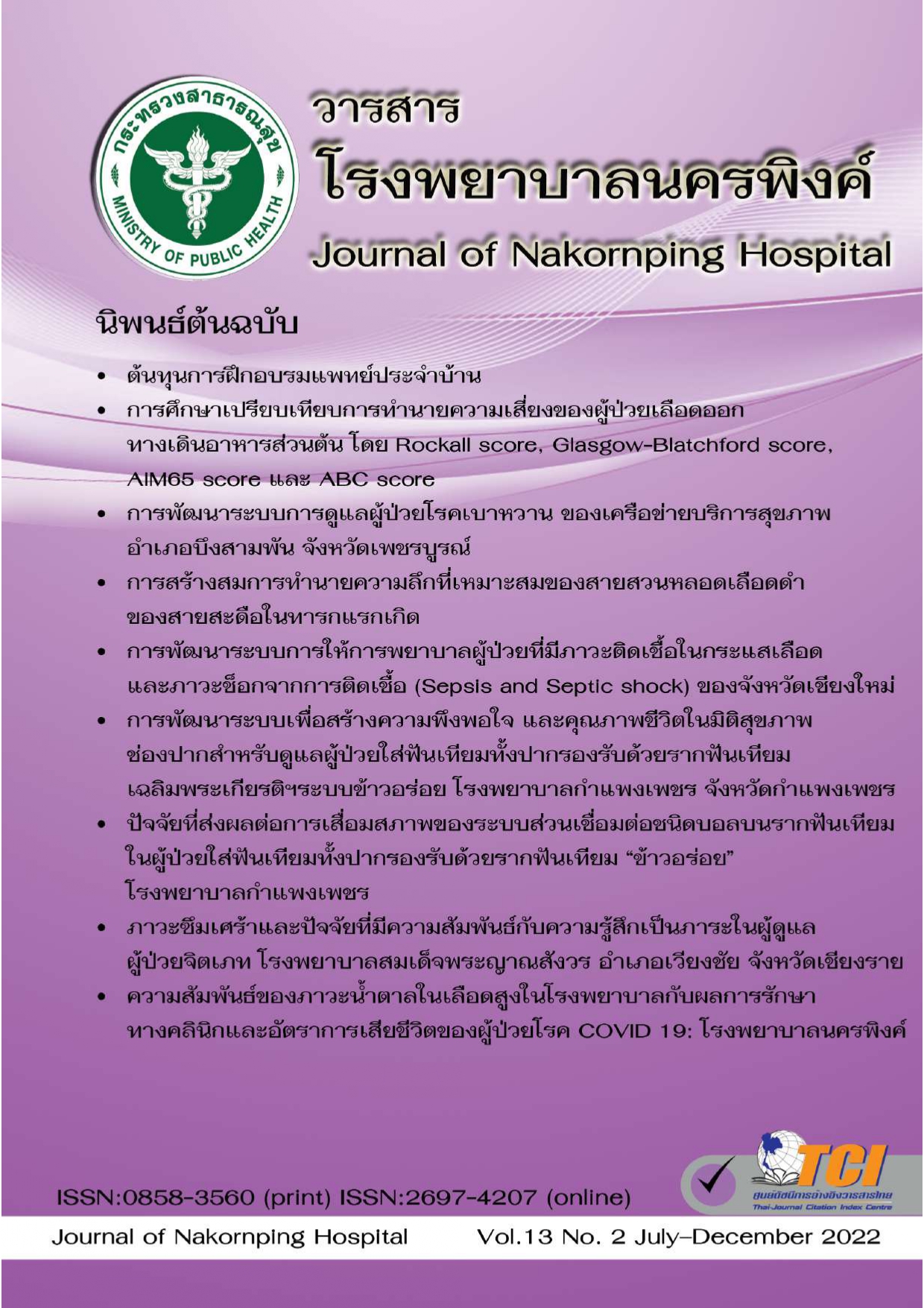The Development of Nursing-Care System for Sepsis and Septic Shock Patients in Chiang Mai Province Thailand
Keywords:
Nursing-care system, sepsis, septic shockAbstract
Sepsis and septic shock are major public health problems due to the rapid onset of the critical disease and high mortality rate. The aim of this action research was to study sepsis and septic shock situations, develop caring system for patients with sepsis and septic shock and then evaluate the effective of system. Data were collected during March 2021 – February 2022. The study was conducted in three phases: 1) situation analysis phase 2) model development phase 3) evaluation phase. The research instruments included patient medical record, in-depth interview questionnaires, focus group discussion, participatory observations, and a model of nursing-care system for sepsis and septic shock.
The results revealed that the problems related to nursing care for patients with sepsis and septic shock reveal as follow 1) low rate of nursing care in NEW score 2) low rate of using screening and diagnosis tool 3) discordant in sepsis and septic shock caring between community hospitals and Nakornping hospital due to lack of caring protocol.
Model of nursing-care system for sepsis and septic shock patients consisted of 1) diagnosis criteria 2) assessment guideline 3) treatment protocol 4) 7 bundles practice guideline at ER and Ward 5) Chiangmai sepsis guideline 6) primary assessment for crisis patients and 7) SEPSIS standing order.
The effective of a model of nursing-care system for sepsis and septic shock patients in Nakornping hospital and community hospitals demonstrated as follow; rate of taking hemoculture before antibiotic treatment were increased by 4.6 vs. 14.3%, rate of providing intravenous fluids in the first hour were increased by 16.0 vs. 10.2%, rate of providing antibiotic treatment within 1 hour after diagnosis were increased by 4.6% while decreased by 2.6% in community hospitals, rate of ICU admission after physician consulting were increased by 18.2 vs. 2.8%, rate of refer was increased by 4.9% in community hospital and mortality rate was increased in Nakorping hospital (2.5%) and decreased in community hospital(1.0%). All seven indicators were achieved (100%).
Conclusions: The situation of sepsis and septic shock are significant problem. Early recognition and appropriate management of a patient with sepsis are needed. The development of clinical guidelines and sepsis screening tools in nursing-care system are established methods to help reduce patient mortality.
References
Martin GS, Mannino DM, Eaton S, Moss M. The epidemiology of sepsis in the United States from 1979 through 2000. N Engl J Med. 2003;348(16):1546-54. doi: 10.1056/NEJMoa022139.
Surannatchayanan P, Kenthongdee W, Kamonrat S. Nursing Care System Development for Sepsis Patients at Loei Hospital. Journal of Nursing and Health Care. 2018;36(1):207-15. (In thai)
Inspection Division, Office of the Inspection Division, Ministry of Public Health. government inspection plan Ministry of Public Health Fiscal Year 2018 [Internet]. Nonthaburi: Office of the Inspection Division, Ministry of Public Health; c2017. Available from: https://bkpho.moph.go.th/bungkanpho/uploads/media/201801170913534421.pdf
Inspection Division, Ministry of Public Health. Ministry of Public Health inspection plan Fiscal Year 2021 [Internet]. Nonthaburi: Inspection Division, Ministry of Public Health; c2021 [cited 2021 Jan 1]. Available from: http://dmsic.moph.go.th/index/detail/8465
Nakornping hospital, Medicine department. KPI Sepsis Service Plan 2018-2022. Chiang mai: Nahornping hospital; 2018.
Niyompruksa A, Chantara P, Yimyam P, Pakdevong N. System Development in Using Clinical Practice Guideline in Caring Patients with sepsis Syndrome. Journal of Nurse association of Thailand, North-Eastern Division. 2013;31(2):14-24. (In thai)
Annane D, Aegerter P, Jars-Guincestre MC, Guidet B; CUB-Réa Network. Current epidemiology of septic shock: the CUB-Réa Network. Am J Respir Crit Care Med. 2003;168(2):165-72. doi: 10.1164/rccm.2201087.
Khwannimit B, Bhurayanontachai R. The epidemiology of, and risk factors for, mortality from severe sepsis and septic shock in a tertiary-care university hospital setting. Epidemiol Infect. 2009;137(9):1333-41. doi: 10.1017/S0950268809002027.
Quick Sepsis-related Organ Failure Assessment, Systemic Inflammatory Response Syndrome, and Early Warning Scores for Detecting Clinical Deterioration in Infected Patients outside the Intensive Care Unit. Am J Respir Crit Care Med. 2017;195(7):906-11. doi: 10.1164/rccm.201604-0854OC.
STRATEGIES FOR INFLUENCE. W. Edwards Deming – PDCA – Quality Management [Internet]. n.p.; c2022 [2020 Aug 5]. Available from: https://strategiesforinfluence.com/w-edwards-deming-pdca-quality-management/
Kemmis S, McTaggart R. Participatory action research. In: Denzin N, Lincoln Y, editors. Handbook of qualitative research. 2nd ed. Thousand Oaks, CA: Sage; 2000. p. 567–605.
Natanson C, et al. Principle of diagnosis and management. Septic shock and multiple organ failure. In: Joseph E. Parrillo, M.D., editors. Critical Care Medicine. Missouri: Mosby-Year Book,Inc; 1995. p. 355-73.
Singer M, Deutschman CS, Seymour CW, Shankar-Hari M, Annane D, Bauer M, et al. The Third International Consensus Definitions for Sepsis and Septic Shock (Sepsis-3). JAMA. 2016;315(8):801-10. doi: 10.1001/jama.2016.0287.
Levy MM, Evans LE, Rhodes A. The Surviving Sepsis Campaign Bundle: 2018 update. Intensive Care Med. 2018;44(6):925-8. doi: 10.1007/s00134-018-5085-0.
Downloads
Published
How to Cite
Issue
Section
License
Copyright (c) 2022 Nakornping Hospital

This work is licensed under a Creative Commons Attribution-NonCommercial-NoDerivatives 4.0 International License.
The articles that had been published in the journal is copyright of Journal of Nakornping hospital, Chiang Mai.
Contents and comments in the articles in Journal of Nakornping hospital are at owner’s responsibilities that editor team may not totally agree with.



